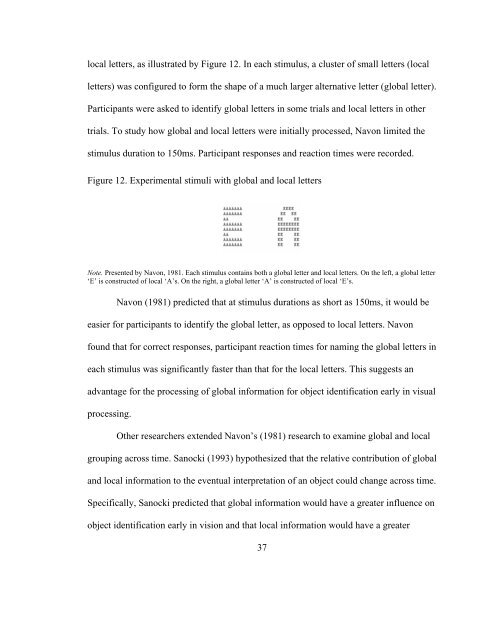The Use of Iambic Pentameter in the
The Use of Iambic Pentameter in the
The Use of Iambic Pentameter in the
Create successful ePaper yourself
Turn your PDF publications into a flip-book with our unique Google optimized e-Paper software.
local letters, as illustrated by Figure 12. In each stimulus, a cluster <strong>of</strong> small letters (local<br />
letters) was configured to form <strong>the</strong> shape <strong>of</strong> a much larger alternative letter (global letter).<br />
Participants were asked to identify global letters <strong>in</strong> some trials and local letters <strong>in</strong> o<strong>the</strong>r<br />
trials. To study how global and local letters were <strong>in</strong>itially processed, Navon limited <strong>the</strong><br />
stimulus duration to 150ms. Participant responses and reaction times were recorded.<br />
Figure 12. Experimental stimuli with global and local letters<br />
Note. Presented by Navon, 1981. Each stimulus conta<strong>in</strong>s both a global letter and local letters. On <strong>the</strong> left, a global letter<br />
‘E’ is constructed <strong>of</strong> local ‘A’s. On <strong>the</strong> right, a global letter ‘A’ is constructed <strong>of</strong> local ‘E’s.<br />
Navon (1981) predicted that at stimulus durations as short as 150ms, it would be<br />
easier for participants to identify <strong>the</strong> global letter, as opposed to local letters. Navon<br />
found that for correct responses, participant reaction times for nam<strong>in</strong>g <strong>the</strong> global letters <strong>in</strong><br />
each stimulus was significantly faster than that for <strong>the</strong> local letters. This suggests an<br />
advantage for <strong>the</strong> process<strong>in</strong>g <strong>of</strong> global <strong>in</strong>formation for object identification early <strong>in</strong> visual<br />
process<strong>in</strong>g.<br />
O<strong>the</strong>r researchers extended Navon’s (1981) research to exam<strong>in</strong>e global and local<br />
group<strong>in</strong>g across time. Sanocki (1993) hypo<strong>the</strong>sized that <strong>the</strong> relative contribution <strong>of</strong> global<br />
and local <strong>in</strong>formation to <strong>the</strong> eventual <strong>in</strong>terpretation <strong>of</strong> an object could change across time.<br />
Specifically, Sanocki predicted that global <strong>in</strong>formation would have a greater <strong>in</strong>fluence on<br />
object identification early <strong>in</strong> vision and that local <strong>in</strong>formation would have a greater<br />
37

















